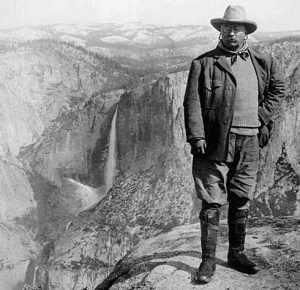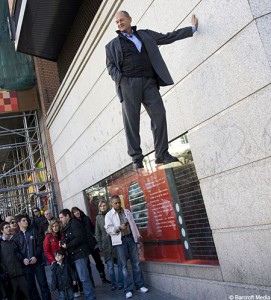 I’m a day late with the St. Patrick’s Day Edition of Quick Hits but that’s no reason not to raise a toast to the saint who, as my great-grandfather William Mullin said, drove all the snakes out of Ireland except the politicians.
I’m a day late with the St. Patrick’s Day Edition of Quick Hits but that’s no reason not to raise a toast to the saint who, as my great-grandfather William Mullin said, drove all the snakes out of Ireland except the politicians.
ADA – Standing
Lessons about the ADA from the CSUN Assistive Technologies Conference
By Richard Hunt in Accessibility Litigation Trends, ADA - drive-by litigation, ADA - serial litigation, ADA - Standing, ADA Attorney's Fees, ADA Internet, ADA Internet Web, ADA Policies Tags: ADA defense, ADA Internet, ADA website, CSUN Assistive, Lainey Feingold, WCAG
 I’m just departing from the 2019 Assistive Technology Conference with a few prejudices confirmed but with some new ideas as well.
I’m just departing from the 2019 Assistive Technology Conference with a few prejudices confirmed but with some new ideas as well.
I spoke with a number of companies that sell consulting services for web accessibility based on a wide range of business models. Since the website litigation storm broke in 2015 the field has developed, but there is still no good accessibility solution for a small retail store or restaurant. Simple websites are less likely to have accessibility issues, but their owners are heavily dependent on small, independent web designers and developers who often live in blissful ignorance of accessibility issues. Twenty-five years after passage of the ADA strip shopping centers that don’t meet ADA standards are still being built because smaller contractors and one person architecture firms don’t know about or understand the construction standards. The same thing will be true for web accessibility twenty-five years from now if we don’t find a way to educate the web design community about it. For those who don’t want to wait the following link has a list of resources from Lainey Feingold’s website. Resources. More
Quick Hits – Presidents Day 2019 Edition.
By Richard Hunt in Accessibility Litigation Trends, ADA - drive-by litigation, ADA - Hotels, ADA - serial litigation, ADA - Standing, FHA Tags: ADA defense, ADA hotels, ADA Mootness, ADA serial litigation, ADA websites, FHA Defense, Scott Johnson, Starbucks
 It’s been a year and 43 blogs since last President’s Day and like Yosemite falls, the broad picture of ADA and FHA litigation in America remains about the same despite the passage of time. A huge majority of the cases filed are from serial litigants operating as part of a lawyer sponsored litigation machine whose goals have nothing to do with accessibility and everything to do with making money. Congressional action aimed at serial litigation was misguided and is now doomed. Individual judges are taking important stances against abusive litigation, but the overall landscape remains about the same. More
It’s been a year and 43 blogs since last President’s Day and like Yosemite falls, the broad picture of ADA and FHA litigation in America remains about the same despite the passage of time. A huge majority of the cases filed are from serial litigants operating as part of a lawyer sponsored litigation machine whose goals have nothing to do with accessibility and everything to do with making money. Congressional action aimed at serial litigation was misguided and is now doomed. Individual judges are taking important stances against abusive litigation, but the overall landscape remains about the same. More
Fourth Circuit decision in ADA web access case is a victory for all defendants.
By Richard Hunt in Accessibility Litigation Trends, ADA - serial litigation, ADA - Standing, ADA Internet, ADA Internet Web, ADA Web Access Tags: ADA defense, ADA internet litigation, ADA website accessibility, ADA Website Litigation, Griffin v Credit Union

 Griffin v. Dept. of Lab. Fed. Credit Union, 18-1312, 2019 WL 80704 (4th Cir. Jan. 3, 2019), decided earlier today, the Fourth Circuit gave the defendant credit union a victory that on its face is meaningful only for credit unions and other membership organizations. However, although its conclusive denial of standing for the plaintiff was stated in the narrowest terms, the reasoning implies a view of standing with much broader implications. Standing requires that a plaintiff have have suffered a past injury that was concrete and particularized, and face the imminent threat of future harm. The Court concluded Griffen met none of these requirements because he was ineligible as a matter of law to use the services of the defendant credit union. More
Griffin v. Dept. of Lab. Fed. Credit Union, 18-1312, 2019 WL 80704 (4th Cir. Jan. 3, 2019), decided earlier today, the Fourth Circuit gave the defendant credit union a victory that on its face is meaningful only for credit unions and other membership organizations. However, although its conclusive denial of standing for the plaintiff was stated in the narrowest terms, the reasoning implies a view of standing with much broader implications. Standing requires that a plaintiff have have suffered a past injury that was concrete and particularized, and face the imminent threat of future harm. The Court concluded Griffen met none of these requirements because he was ineligible as a matter of law to use the services of the defendant credit union. More
ADA and FHA Quick Hits – Happy New Year edition
By Richard Hunt in Accessibility Litigation Trends, ADA, ADA - drive-by litigation, ADA - serial litigation, ADA - Standing, ADA Attorney's Fees, ADA Class Actions, ADA Internet, ADA Internet Web, ADA Litigation Procedure, ADA Mootness, ADA Web Access, FHA, FHA design/build litigation Tags: ADA defense, FHA Defense, Lyft, Ride Sharing ADA, uber
 There is only one prediction that can be made with complete certainty about ADA and FHA litigation in 2019: Lawyers will continue to make money exploiting these laws for profit in the name of accessibility. The number of lawsuits continues to climb, and with Congress and regulators unwilling to do anything this exploitation will continue. However, before we face the new challenges of a new year it is time for a final look backward at the recent decisions concerning accessibility for the disabled.
There is only one prediction that can be made with complete certainty about ADA and FHA litigation in 2019: Lawyers will continue to make money exploiting these laws for profit in the name of accessibility. The number of lawsuits continues to climb, and with Congress and regulators unwilling to do anything this exploitation will continue. However, before we face the new challenges of a new year it is time for a final look backward at the recent decisions concerning accessibility for the disabled.
Standing in website accessibility cases.
Price v. Orlando Health, Inc., 2018 WL 6434519, at *4 (M.D. Fla. Dec. 7, 2018) shows just how important theories about why the ADA covers websites can be to standing in such cases. Courts in the 11th Circuit have adopted the theory that a website is covered by the ADA only if it has a nexus to a physical public accommodation. Because this relationship is required, the ADA injury giving rise to standing must be some inability to use the physical accommodation. The plaintiff in this case had no plausible intent to use the defendant’s facilities so he could not establish an ADA injury and did not have standing to sue. This is one of many reasons there is a widening gap between the Circuits with respect to how website cases can be effectively defended. More

